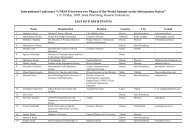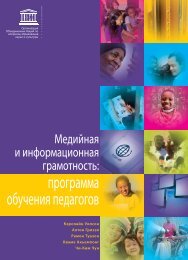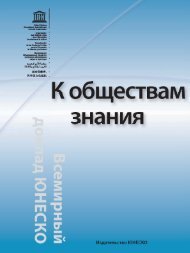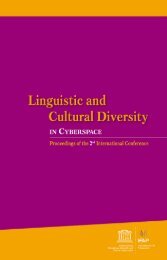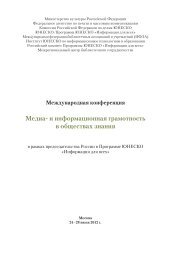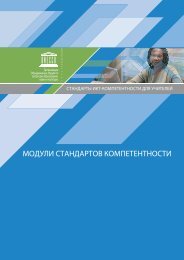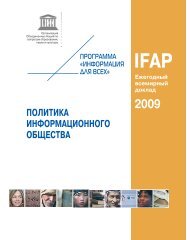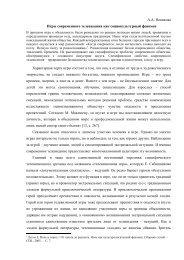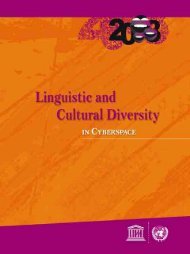Internet and Socio-Cultural Transformations in Information Society
Internet and Socio-Cultural Transformations in Information Society
Internet and Socio-Cultural Transformations in Information Society
- No tags were found...
Create successful ePaper yourself
Turn your PDF publications into a flip-book with our unique Google optimized e-Paper software.
M<strong>in</strong>istry of Culture of the Russian FederationFederal Agency for Press <strong>and</strong> Mass CommunicationsGovernment of the Sakhal<strong>in</strong> RegionCommission of the Russian Federation for UNESCOUNESCO / UNESCO <strong>Information</strong> for All ProgrammeRussian Committee of the UNESCO <strong>Information</strong> for All ProgrammeInterregional Library Cooperation Centre<strong>Internet</strong><strong>and</strong> <strong>Socio</strong>-<strong>Cultural</strong><strong>Transformations</strong><strong>in</strong> <strong>Information</strong> <strong>Society</strong>Yuzhno-Sakhal<strong>in</strong>sk7–12 September 2013
Round Table“Multil<strong>in</strong>gualism<strong>in</strong> the Digital World”Redef<strong>in</strong><strong>in</strong>g the Digital Dividearound <strong>Information</strong> Literacy<strong>and</strong>L<strong>in</strong>guistic Diversity<strong>in</strong> a future contextof access provision
Daniel Pimientapimienta@funredes.orgNETWORKS & DEVELOPMENTFOUNDATIONhttp://funredes.orghttp://funredes.org/LC
MEMBER OF EXECUTIVECOMMITEEhttp://maaya.org
TWO VISIONSOF DIGITAL DIVIDEFOR COMPUTERSMINDED PERSONSFOR INFORMATIONMINDED PERSONSA MATTEROF ACCESSALSO A MATTER OFEDUCATION
TWO VISIONSOF DIGITAL DIVIDE“<strong>Internet</strong> is forevery one!”“Let’s connectthe next billionusers”“Broadb<strong>and</strong>commission”Digital literacy<strong>Information</strong>LiteracyTechnologyownership
A VISION OF THE DIGITAL DIVEFROM THE HUMANDEVELOPMENT PERSPECTIVE…AND FROM FIELD EXPERIENCES INTHE SOUTH
REFERENCE“Digital divide, Social divide,Paradigmatic divide”,Daniel Pimienta, july 2007In Spanish, French <strong>and</strong> English.
IS THIS APPROACH STILL VALID7 YEARS LATER?LET’S IDENTIFYTHE MAIN EVENTSOF LAST YEARS INTERNET EVOLUTIONAND CHECKFOUR MAIN LINES OF CHANGES.
LAST YEARS INTERNETEVOLUTION1- TECHNOLOGYMOBILE + SMARTPHONES + BROADBAND +WIRELESS + VIDEO
LAST YEARS INTERNETEVOLUTION2 – THE DEVELOPMENT ENGINESSEARCH ENGINES + THE ADVERTISMENT BASEDECONOMICAL MODEL+ THE LOST OFVIRGINITY OF “MISS PRIVACY”
TLE LOST OF PRIVACY1993 2013
LAST YEARS INTERNETEVOLUTION3- MAINLINE APPLICATIONSWEB 2.0 + THE LOST OF ASYNCHRONISM + THERAPE OF MADAME PRIVACY
LAST YEARS INTERNETEVOLUTION4 – HUMAN TOPOLOGYTHE INTERNET DEMOGRAPHIC CHANGES90%80%70%ENGLISH60%%50%40%% INTERNET USERS% WEB PAGES30%20%10%0%1996 1997 1998 1999 2000 2001 2002 2003 2004 2005 2007Year
IS THIS APPROACH STILL VALID7 YEARS LATER?MY OPINION IS “YES, STILL MORE!”ACCESS IS EVERY DAY LESS OF A PROBLEMANDTHE DIGITAL DIVIDE IS EVERY DAY MOREA QUESTION OF EDUCATION THANACCESS
THE CONTENT DIVIDE
REFERENCE-”Access<strong>in</strong>g Contents”, D. Pimienta, Chapter of Global <strong>Information</strong><strong>Society</strong> Watch, APC, HIVOS, ITEM, 2008http://www.giswatch.org/gisw2008/thematic/Access<strong>in</strong>gContent.html
DIGITAL DIVIDE IS MUCHDEEPER IN TERMS OFCONTENTSTHAN IN TERMS OFACCESS
AFRICA FOR EXAMPLE4.8% of <strong>Internet</strong> users(source <strong>Internet</strong>WorldStats – 2010)0.6% of English web pages(source FUNREDES/UL 2007)0.6% of French web pages(source FUNREDES/UL 2007)African local languages weight each between0,006 % & 0,06 % of total web pages(source LOP 2007)
IMPLICATIONS OF CONTENTDIVIDE1) Do those people have the accessorganized <strong>in</strong> their mother tongue?2) If so do they f<strong>in</strong>d the density <strong>and</strong>variety of contents <strong>in</strong> their mothertongue comparable to English?If not ACCULTURATION RISK IS HIGH
HOW TO FOSTER CONTENT?INTERNETCONTENTSKNOWKEDGE
THE LINGUISTIC DIVIDE
REFERENCESTwelve years of measur<strong>in</strong>g l<strong>in</strong>guisticdiversity <strong>in</strong> the <strong>Internet</strong>: balance <strong>and</strong>perspectives”, UNESCO/2009.http://portal.unesco.org/ci/en/ev.php-URL_ID=29594&URL_DO=DO_TOPIC&URL_SECTION=201.htmlMeasur<strong>in</strong>g l<strong>in</strong>guistic diversity on the<strong>Internet</strong>, UNESCO, 12/2005http://portal.unesco.org/ci/en/ev.php-URL_ID=20882&URL_DO=DO_TOPIC&URL_SECTION=201.html
LETS GET A ROUGH FIGURE OFREALITY 40,000 lenguages has existed Between 6,000 & 9,000 still alive Every 2 months one disappears Some 500 are localized Wikipedia h<strong>and</strong>les 264 languages Google works <strong>in</strong> 45 languages … <strong>and</strong> I am speak<strong>in</strong>g here <strong>in</strong> English
LETS GET A ROUGH FIGUREOF REALITY!
LETS GET A ROUGH FIGUREOF REALITYENGLISH%90%80%70%60%50%40%30%20%10%0%%90%80%70%60%50%% INTERNET USERS% INTERNET USERS40%% WEB PAGES% WEB PAGES30%20%10%0%1996 1997 1998 1999 2000 2001 2002 2003 2004 2005 20071996 1997 1998 1999 2000 2001 Year 2002 2003 2004 2005 2007YearFuente: FUNREDES/ULSOURCE: FUNREDES/UL 2007
LINGUISTIC DIVERSITY IN THEINTERNET Paradoxical situationIDNINTERNET’s REALLYFOR EVERY ONE?INDICATORS
CONCLUSIONSTHE INTERNET DOES HAVEFRONTIERSLANGUAGES ARE THE FRONTIERSOF THE INTERNET
CONCLUSIONSINTERNET DEMOGRAPHICSCALL FOR SETTING HIGH PRIORITYTO LANGUAGES SUPPORT ANDCONTENT FOSTERING
CONCLUSIONSMASSIVE DIGITAL AND INFORMATIONLITERACYIS THE ONLY WAY TO TRIGGER MASSIVEAND QUALITY CONTENT PRODUCTIONCOMPREHENSIVE POLICIES FORDIGITAL DIVIDE MUST GOBEYOND ACCESSAND INCLUDE EDUCATION
GraciasToda rabaOrkunMERCIThank youAbharObrigadoAmesegnalhuDhonnyobaadAdjaramaShukranDekujiDoh jehN’gue penùспасибо




